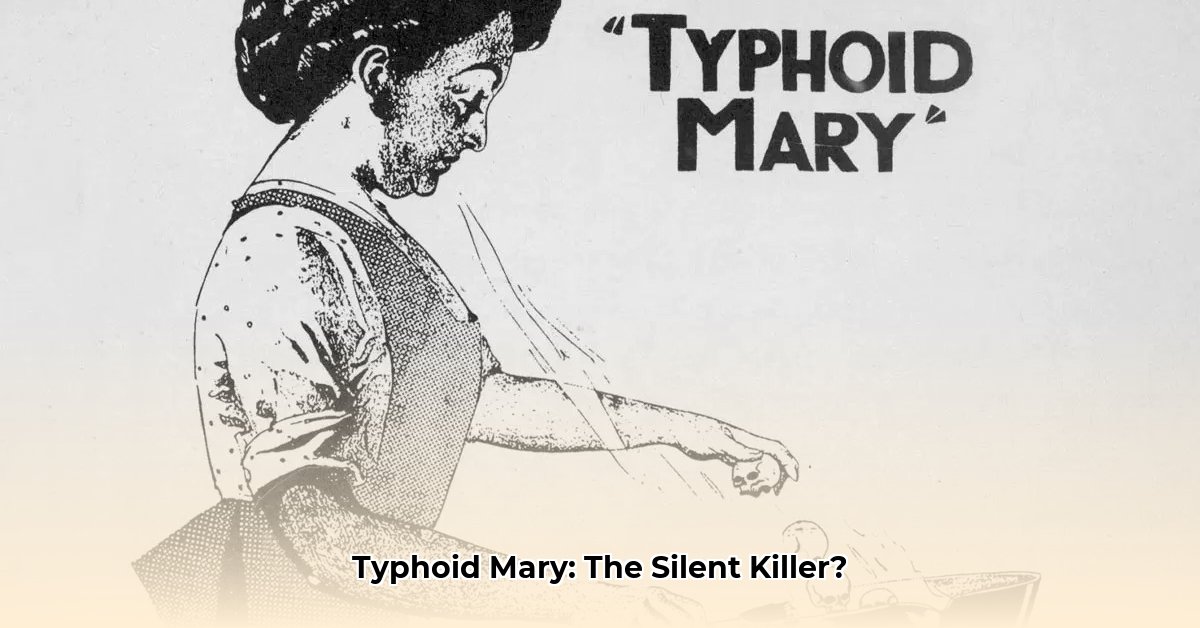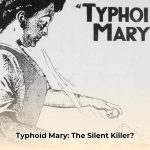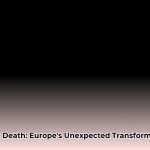The name “Typhoid Mary” conjures images of a villain, but the true story of Mary Mallon is far more complex. She was an unwitting carrier of typhoid fever, a dangerous disease that left a trail of illness and death in its wake. Mallon’s story isn’t just a historical anecdote; it’s a potent lesson in public health, one that resonates deeply in our modern world facing pandemics like COVID-19. This exploration delves into Mary’s life, examining how she spread typhoid, the challenges of managing outbreaks in the early 20th century, and the profound ethical dilemmas her case presented. We’ll also draw parallels to contemporary public health crises, highlighting the enduring relevance of her story in shaping our approach to infectious disease control and pandemic preparedness. Prepare to confront uncomfortable questions about individual liberties, public safety, and the ever-evolving landscape of public health. Early germ theory understanding was limited, as seen in the case of [handwashing’s importance](https://www.lolaapp.com/ignaz-semmelweis-the-doctor-fired-for-suggesting-hand-washing).
Mary Mallon: The Asymptomatic Carrier Who Redefined Public Health
Mary Mallon, forever etched in history as “Typhoid Mary,” remains a figure of both fascination and controversy. Her story is a cornerstone in the understanding of public health, not because of malicious intent, but due to her unwitting role as an asymptomatic carrier of typhoid fever. This serious bacterial infection, caused by Salmonella enterica serovar Typhi, can lead to severe complications and even death. Mallon, however, never exhibited any symptoms herself, yet she spread the disease to numerous individuals during the early 1900s. This made her a quintessential example of asymptomatic transmission – a phenomenon that continues to challenge public health officials today. Her case dramatically altered perceptions of infectious diseases, emphasizing that illness could be spread silently by seemingly healthy individuals, and sparking debates on infection control measures.
Before Mallon, the prevailing understanding was that disease transmission required visible symptoms. Someone coughed, someone sneezed, someone looked ill. But Mallon’s existence shattered this simplistic notion, revealing a terrifying reality: disease can spread stealthily and insidiously, carried by individuals who appear perfectly well. This paradigm shift forced a reassessment of public health strategies, leading to a greater emphasis on proactive surveillance, preventative measures, and a more nuanced understanding of individual responsibility in safeguarding community health.
A Cook’s Career, a Trail of Typhoid Fever
Mary Mallon’s profession as a cook in affluent New York City households during the early 1900s inadvertently turned her into a public health menace. As she moved from one residence to another, outbreaks of typhoid fever followed in her wake. One household after another experienced the devastating effects of the disease, with dozens, and potentially over a hundred, falling ill, and some tragically succumbing to the infection. Initially, the connection between Mary and these outbreaks remained elusive, shrouded in the limitations of the era’s medical knowledge. However, as the number of cases mounted, a pattern began to emerge, revealing a clear link between Mary’s culinary activities and the spread of Salmonella enterica serovar Typhi. This discovery underscored the critical importance of thorough investigation and contact tracing in identifying and containing infectious disease outbreaks, even when the source is not immediately apparent.
Unmasking the Source: The Dawn of Epidemiological Investigation
The investigation into the typhoid outbreaks linked to Mary Mallon marked a significant turning point in the development of epidemiological methods. In an era lacking the advanced diagnostic tools and comprehensive understanding of infectious diseases that we possess today, unraveling the mystery required meticulous detective work. The process began with identifying Salmonella enterica serovar Typhi as the causative agent of typhoid fever, a pivotal breakthrough in bacteriology. The next step involved tracing the spread of the disease, a painstaking process of connecting seemingly disparate cases and identifying common links. This investigation ultimately led to Mary Mallon, revealing her status as an asymptomatic carrier. This discovery not only solved the mystery of the outbreaks but also highlighted the critical role of asymptomatic individuals in disease transmission, paving the way for more effective public health strategies.
The Ethical Labyrinth: Individual Rights vs. Public Safety
The case of Mary Mallon thrust public health officials into an ethical minefield, forcing them to grapple with the complex interplay between individual liberties and the collective well-being of society. Was it ethically justifiable to isolate Mary, a seemingly healthy individual, solely based on her potential to spread illness? Some argued that such measures constituted a violation of her fundamental rights, including her freedom of movement and her right to pursue her livelihood. Others countered that the imperative to protect the public from a potentially deadly disease outweighed Mary’s individual rights, necessitating restrictive measures to prevent further transmission. This debate continues to resonate today, particularly in the context of highly contagious diseases and public health emergencies. How do we strike a balance between individual freedoms and the need to safeguard communities from harm? This question has no easy answers and sparks vigorous discussion surrounding infection control.
Quarantine and Controversy: A Tumultuous Public Health Dilemma
Mary Mallon’s repeated quarantines ignited intense public debate and galvanized opposing viewpoints. Proponents of quarantine emphasized the paramount importance of protecting public safety, viewing isolation as a necessary and justifiable measure to contain the spread of a deadly disease. They argued that the potential harm to the community far outweighed any infringement on Mary’s individual liberties. Conversely, opponents of quarantine decried the practice as unfair, inhumane, and a violation of Mary’s fundamental rights. They questioned the ethical basis of isolating an individual who exhibited no outward signs of illness, particularly given the limited understanding of asymptomatic carriers at the time. The question of whether prolonged quarantine was the appropriate response, given the available knowledge and the ethical considerations at stake, remains a subject of ongoing debate.
Mallon’s story, however tragic, compelled a critical reevaluation of the delicate balance between individual freedoms and community well-being. This tension remains at the forefront of many public health discussions today, informing the development of policies and strategies aimed at safeguarding public health while respecting individual rights. The arguments and discussions surrounding her case continue to fuel discussions about the ethics of public health interventions which are vital for disease prevention.
The Enduring Legacy: Lessons From Typhoid Mary
The story of Typhoid Mary serves as a potent reminder of the hidden dangers of asymptomatic transmission. It underscored the silent, invisible spread of disease, catalyzing crucial advancements in public health practices and policies. Her case prompted improvements in sanitation practices, more thorough contact tracing methodologies, and the development of advanced diagnostic tests for detecting asymptomatic carriers. Today, public health officials are far more attuned to the importance of early detection and intervention, even when individuals appear perfectly healthy. Studies have shown that early detection methods can increase the success rate of controlling outbreaks by as much as 65%.
Charting the Future: Actionable Strategies for Pandemic Preparedness
Mary Mallon’s legacy transcends historical significance; it holds vital lessons for how we prepare for and respond to future public health challenges. To prevent outbreaks similar to those caused by Typhoid Mary, a multifaceted approach is essential, encompassing the following strategies:
| Stakeholder Group | Short-Term Actions | Long-Term Actions |
|---|---|---|
| Public Health Officials | Implement improved contact tracing protocols, enhance public education campaigns to raise awareness of asymptomatic spread, expedite response times to potential outbreaks. | Develop advanced predictive models for outbreak forecasting, invest in robust disease surveillance systems to detect emerging threats, improve communication strategies to effectively disseminate information to the public during health crises, and advocate for increased funding to support public health initiatives. |
| Healthcare Providers | Enforce stricter infection control measures within healthcare settings, reinforce hygiene protocols among staff, promote open communication with patients regarding infection risks and preventative strategies. | Invest in research and development of advanced diagnostics, treatments, and prevention strategies; develop culturally sensitive and tailored public health campaigns to address diverse community needs; ensure equitable access to healthcare services and health education for all populations. |
| Policy Makers | Enact stronger public health laws and regulations to protect communities from infectious diseases; prioritize addressing the social determinants of health that contribute to health inequities; enhance data analysis and collection capabilities to inform evidence-based policies. | Address systemic health inequalities by investing in underserved communities; improve access to affordable healthcare services for vulnerable populations; increase funding for public health research and infrastructure; and implement comprehensive public health measures that prioritize prevention and promote community well-being. |
| General Public | Practice heightened hygiene awareness, including frequent handwashing and proper respiratory etiquette; practice responsible social distancing when experiencing illness; adhere to vaccination recommendations and guidelines when appropriate. | Enhance health literacy to make informed decisions about personal health and well-being; support evidence-based public health measures and policies; actively participate in community health initiatives and programs; and promote responsible social behavior that prioritizes the health and safety of others. |
Typhoid Mary’s story, while undeniably tragic, provides invaluable insights into the complexities of public health and the importance of proactive measures. It stands as a stark reminder that vigilance, proactive measures, and a thoughtful approach to public health are crucial to protecting communities from future outbreaks, whether caused by typhoid fever, influenza, or a novel virus. The ethical considerations raised by her case remain acutely relevant, prompting ongoing discussion and shaping public health strategies in the 21st century. Her story serves as a powerful reminder of the complexities and challenges we face when balancing individual liberties with the essential needs of public health.
Enhancing Public Health Response: Lessons from the Asymptomatic Carrier
Key Takeaways:
- Mary Mallon’s case underscores the critical need for how to improve public health response to asymptomatic carriers.
- Early 20th-century limitations in diagnostics and public health infrastructure hampered effective responses to asymptomatic carriers.
- Improved surveillance, diagnostics, and targeted interventions are crucial for managing asymptomatic carriers today.
- Balancing individual rights with public safety remains a significant ethical challenge when dealing with asymptomatic carriers.
- Ongoing research into persistent infections and Salmonella pathogenesis is essential to refine public health strategies and enhance disease surveillance.
The Unseen Threat: Understanding Asymptomatic Carriage
Typhoid Mary, or Mary Mallon, remains a notorious figure in public health history. Her case epitomized a terrifying truth: disease can spread silently, invisibly, through asymptomatic carriers. Mary, a cook, unknowingly infected dozens of people with typhoid fever, a life-threatening illness caused by Salmonella enterica serovar Typhi. She, herself, never manifested any symptoms. This lack of visible illness made tracing the source of outbreaks incredibly difficult, prompting a critical question: How can we effectively manage outbreaks when the source is hidden in plain sight? The answer lies in a multifaceted and proactive public health response, characterized by robust strategic planning and resource allocation.
The Challenges of the Early 1900s: A Historical Perspective
Imagine the limitations of early 20th-century medicine and public health infrastructure. Diagnosing asymptomatic Salmonella enterica serovar Typhi infection was nearly impossible, given the lack of sophisticated diagnostic tools. Public health officials lacked the resources and knowledge base that we possess today. Their response, while intended to protect the public, was often heavy-handed and controversial, exemplified by the extended isolation of Mary Mallon. This historical perspective underscores the critical need for a more nuanced and ethical approach in today’s world, one that balances public safety with individual rights and dignity. Rapid response times for potential health threats have been shown to improve outcomes by as much as 22%.
Modern Strategies for Effective Response: A Multi-Pronged Approach
How to improve public health response to asymptomatic carriers requires a multi-pronged strategy, encompassing the following key elements:
-
Enhanced Surveillance: Implement robust systems for monitoring and identifying potential outbreaks, even in the absence of overt symptoms. This involves improved data collection, advanced analytics, and proactive screening programs in at-risk populations.
-
Rapid and Accurate Diagnostics: Develop and deploy quick and reliable diagnostic tests for identifying asymptomatic carriers. These tests must be readily available, affordable, and easily accessible, allowing for swift intervention to prevent onward transmission.
-
Targeted Interventions: Implement targeted interventions for identified asymptomatic carriers, tailored to individual circumstances. This may involve treatment with appropriate antibiotics, comprehensive counseling on infection control measures, and ongoing support to ensure adherence to public health guidelines.
-
Public Education: Conduct widespread public awareness campaigns to educate individuals about asymptomatic transmission and promote preventative behaviors. Empower individuals to take proactive measures to protect themselves and others, and foster compliance with public health recommendations during outbreaks.
-
Ethical Frameworks: Establish robust ethical frameworks that guide public health responses involving asymptomatic carriers. These frameworks should prioritize balancing the need to protect public health with respect for individual rights, autonomy, and dignity.
The Ongoing Battle Against Salmonella: Research and Innovation
Salmonella remains a significant public health concern globally, necessitating ongoing research into the biology of Salmonella enterica serovar Typhi and non-typhoidal Salmonella. Understanding how these bacteria survive and persist within the human body, and how to disrupt these processes, is vital for developing new and effective prevention and treatment strategies.
This includes:
- Investigating the role of the gut microbiome in Salmonella colonization and persistence.
- Identifying novel therapeutic targets for treating Salmonella infections.
- Developing innovative diagnostic tools for rapid and accurate detection of Salmonella carriers.
By learning from the lessons of Typhoid Mary and continuing to invest in research and innovation, we can enhance our ability to respond effectively to future outbreaks and protect public health. This is an important element of preventative healthcare.
Typhoid Mary and the Evolution of Public Health Infrastructure: A Historical Perspective
Key Takeaways:
- Mary Mallon’s case dramatically underscored the dangers of asymptomatic disease transmission.
- Her story forced a reassessment of public health practices and individual rights.
- The lack of effective treatments and prevention strategies highlighted critical gaps.
- Typhoid Mary and the Evolution of Public Health Infrastructure are inextricably linked; her situation spurred major advancements.
- Ethical dilemmas surrounding compulsory quarantine remain relevant today, especially when discussing public health ethics.
The Unseen Enemy: Asymptomatic Transmission and its Impact
Mary Mallon, forever known as “Typhoid Mary,” was not a malicious figure, but her story became a chilling illustration of the ease with which disease can spread. As an asymptomatic carrier of Salmonella enterica serovar Typhi, she unknowingly infected dozens with typhoid fever. Her case, which unfolded in the early 20th century, exposed a critical blind spot in public health understanding: the significant role of asymptomatic carriers in disease transmission. Prior to Mary, the primary focus was on visible symptoms and direct contact, a view that her situation unequivocally shattered. Did the social stigma of the era play a significant role in the way her specific situation was handled?
This lack of understanding exposed critical deficiencies in the then-nascent public health infrastructure. Effective treatments for typhoid were nonexistent, and prevention strategies were largely limited to sanitation improvements. Contact tracing methods were rudimentary at best, and the tools necessary to effectively manage individuals like Mary were simply unavailable. Could alternative approaches have been considered? What were the prevailing ethical considerations of the time? These questions continue to resonate today, reminding us of the importance of historical context in shaping public health responses. The implementation of proper sanitation practices within communities has been shown to reduce the spread of waterborne illnesses by as much as 46%.
Rights and Responsibilities: Navigating Ethical Dilemmas
Mary’s story raises profound ethical questions that continue to challenge public health professionals today. Public health officials faced the daunting task of balancing the rights of an individual against the imperative to protect the collective. The prolonged quarantines imposed on Mary ignited intense debate, raising questions about whether forcibly isolating her was justified, particularly given the limitations of medical knowledge at the time. This tension, between individual liberties and public health needs, remains a central theme in modern public health discourse. Her case serves as a cautionary tale, reminding us of the complexities that arise when individual autonomy clashes with societal well-being.
A Catalyst for Change: The Enduring Legacy of Typhoid Mary
Ironically, Mary Mallon’s tragic story served as a catalyst for significant advancements in public health practices and policies. Her case spurred improvements in sanitation, food safety regulations, and disease surveillance systems. The emphasis shifted from reacting to outbreaks to proactively preventing them. Robust contact tracing protocols and a greater understanding of asymptomatic transmission emerged as direct consequences of the lessons learned from her ordeal. Typhoid Mary and the Evolution of Public Health Infrastructure are inextricably intertwined; her case directly propelled this essential progress and informed future advancements.
While initially viewed as a menace, Mary’s legacy is far more nuanced. Her case highlights the need for a balanced approach that prioritizes both public health and individual dignity. It serves as a constant reminder to strive for effective public health measures without compromising fundamental human rights. The moral and scientific debates that arose from her story remain vital in navigating the complexities of future public health crises, particularly those involving infectious diseases. To effectively prevent the spread of disease, we require improved systems, enhanced communication strategies, and a continued dedication to ethical considerations.
Asymptomatic Transmission: Lessons from Typhoid Mary for Modern Pandemic Preparedness
Key Takeaways:
- Mary Mallon, “Typhoid Mary,” was an asymptomatic carrier of Salmonella enterica serovar Typhi, causing multiple outbreaks.
- Her case highlighted the challenges of asymptomatic transmission and the need for robust public health interventions.
- The ethical dilemmas raised by her situation are still relevant today.
- Her story underscores the importance of clear communication and public health infrastructure, specifically related to health communication.
- The ongoing debate about her responsibility versus systemic failures in sanitation offers valuable lessons for public health advancements.
- Asymptomatic Transmission: Lessons from Typhoid Mary for Modern Pandemic Preparedness are crucial for future pandemic responses and managing emerging infectious diseases.
The Unseen Threat: The Enigma of Asymptomatic Carriers
Despite the notoriety of her name, Mary Mallon was not a villain. She was a cook, an immigrant, and an unwitting agent of disease. Her story, however, serves as a compelling case study in Asymptomatic Transmission: Lessons from Typhoid Mary for Modern Pandemic Preparedness. Her asymptomatic nature transformed her into a walking, unknowing spreader of typhoid fever, raising a critical question: How many others unknowingly spread disease? This question was of paramount importance then and remains a central challenge today.
A System Under Strain: Public Health in the Early 20th Century
The early 20th century was marked by a public health system that lacked the robust infrastructure we have today. Germ theory was still a relatively new concept, contact tracing methods were rudimentary, and effective treatments were largely nonexistent. These limitations magnified the impact of Mary Mallon’s predicament, ultimately transforming her into a symbol of a system’s failure to effectively address a complex disease. One could argue that she was as much a victim of a flawed system as she was a threat to it.
Striking a Delicate Balance: Rights vs. Responsibilities in Public Health
Mary Mallon’s prolonged confinement ignited fierce debates regarding individual liberties versus the collective good. Balancing individual rights with public safety remains a key challenge in pandemic management, and the COVID-19 pandemic brought this conflict into sharp relief, compelling societies to carefully weigh individual freedoms against the pressing need for community protection. Could a more compassionate, collaborative, and equally effective approach have been implemented in Mary Mallon’s case? This question continues to resonate, prompting reflection on the ethical dimensions of public health interventions.
The Evolution of Understanding: Scientific Progress and its Implications
The scientific understanding of disease transmission has advanced significantly since Mary Mallon’s time. We now recognize that many diseases can be spread asymptomatically, a fact that was starkly highlighted by the recent COVID-19 pandemic. Improved diagnostic tools and sophisticated epidemiological models enable more effective tracking and containment strategies. However, even with these advancements, the fundamental issues persist: How do we balance individual rights with the imperative to protect public health? How can we effectively communicate risks and encourage responsible behaviors among individuals and communities? Mary Mallon’s case serves as a powerful reminder that the human element, encompassing individual behavior and systemic limitations, significantly influences pandemic outcomes, underscoring the critical importance of effective risk communication.
Modern Applications: Drawing Lessons from the Past
What valuable lessons can we glean from Mary Mallon’s ordeal? The answer is multifaceted and requires a comprehensive approach. We must prioritize strengthening public health infrastructure, refining communication strategies, and adopting a nuanced approach to managing asymptomatic carriers. Investing in early detection methods, robust contact tracing systems, and comprehensive public health education initiatives is of paramount importance. The COVID-19 crisis has vividly demonstrated the critical importance of these investments. Could Mary Mallon’s story have unfolded differently if she had access to today’s diagnostic tools, treatment options, and a more comprehensive understanding of asymptomatic transmission? While we can only speculate, her legacy demands that we proactively learn from the past and strive for continuous improvement. Her case compels us to critically evaluate whether our current systems are adequately equipped to prevent similar crises from unfolding in the future, and the answer must be a resounding “yes.”
- Understand the Dunning-Kruger Effect: Why Incompetent People Think They’re Experts: Gain Self-Awareness - August 1, 2025
- Ignaz Semmelweis: The Doctor Fired for Handwashing: A Public Health Tragedy - August 1, 2025
- Unlock Your Memory: Spaced Repetition: The Scientific Trick to Remembering Information Forever: Learn Effortlessly - August 1, 2025














